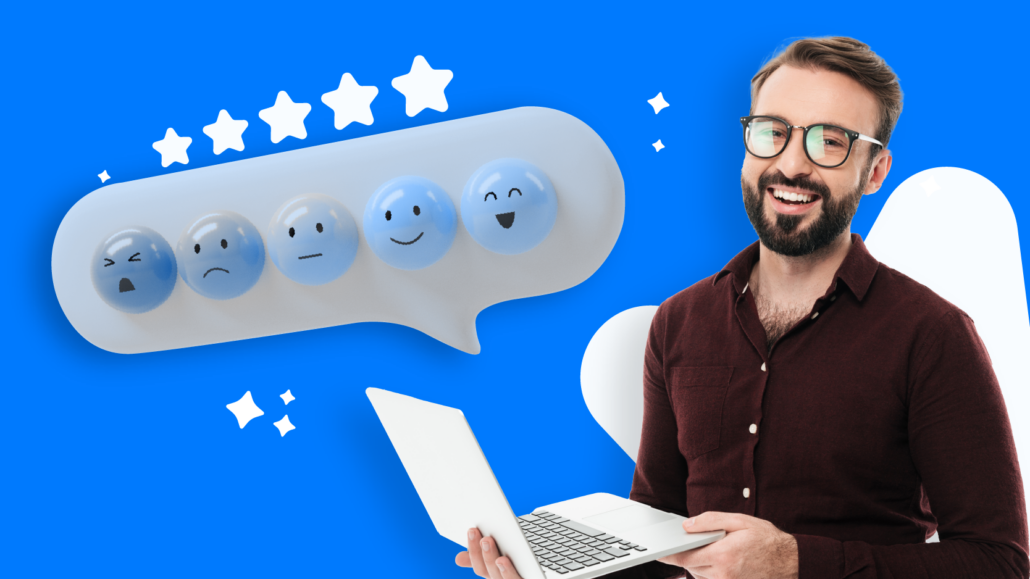In 2021, customer-facing digital experiences was a top priority for 89% of brands.
But is it still a differentiator?
Perhaps, not.
Almost every brand is now able to deliver the same level of digital experiences.
And yet, 58% of customers state that a brand’s digital experience has little to no impact on what they end up buying.
How, so?
What we sense here is, brands have, to some extent, successfully digitized the pre-purchase experiences.
But there’s more to the definition of customer experience.
Customer experience or CX is a sum of all the cognitive, affective, sensory, and behavioral responses during all stages of a buyer’s journey.
A great experience in all the above areas can help build a positive brand perception and impact brand preference by 37%.
Best of all, good CX has a direct influence on purchase decisions.
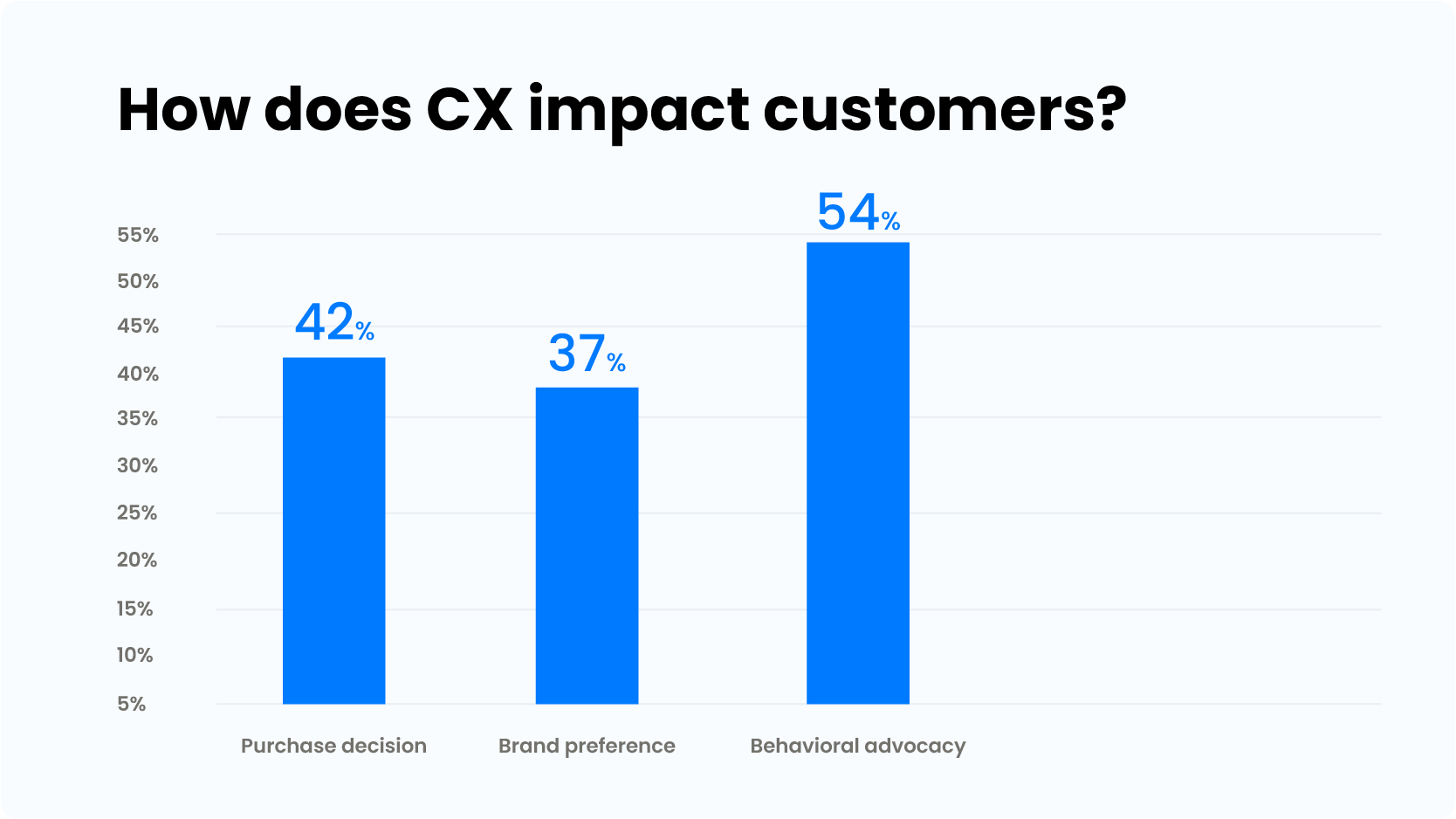
More purchases, higher revenue and faster growth.
That’s why customer experience matters.
Let’s dive into the various aspects of customer experience.
What is CX?
Customer experience or CX is not a new concept.
In 2007, HBR wrote:
Customer experience is the subjective response customers have to direct or indirect contact with a company. It encompasses every aspect of an offering: customer care, advertising, packaging, features, ease of use, reliability.
At that time, digital technology was still in its nascent stage.
Today, digital experience has become an integral part of the overall customer experience.
So, the definition of customer experience has also evolved.
For some brands, it’s a frictionless journey. For others, it’s a memorable experience.
Similarly, you may find many different definitions and explanations of CX.
But they all point to the same main concept – how customers perceive your brand through the experiences they get from using your product/service and interacting with you digitally.
If this sounds a lot like user experience, you’d be right – they do sound similar.
However, there are several differences between customer experience and user experience. Let’s understand both these terms in detail.
Customer Experience vs. User Experience
| CX | UX | |
Definition | Customer experience focuses on holistic customer experience. CX deals with a customer’s entire experience with a brand. | User experience concentrates on a single goal- to optimize a product for complete user satisfaction. |
Major KPIs | Customer experience KPIs give an in-depth view of what every customer goes through. Some of the well-known CX KPIs are: Customer Lifetime Value, Net Promoter Score, Customer Acquisition cost | UX KPIs solely concentrate on the product and its impact on the user. Some of the major UX KPIs are: Success rate, the margin of error, abandonment rate |
Professional activities | CX professionals focus on voicing customer opinions and improving the brand’s image. They conduct market research to understand what customers want from their brand. | UX professionals focus on research to improve the product alone. UX designers create prototypes, user personas and test the product. |
| Channels of engagement | CX is omnichannel and all-encompassing. It focuses on the larger audience and their every interaction with the brand. | UX is mainly digital, which is a single channel. For example, web or mobile apps. |
In a nutshell, customer experience has a lot more to do with the customer than the product. But CX and UX should be of equal importance in any organization.
If usability is bad, customers won’t buy the product no matter how good their experiences are. And vice versa; terrible customer experiences will ensure that a product never shines.
This brings us to another major aspect of customer experience – expectations.
While brands thrive to improve CX, not everyone is meeting the expectations of their customers. For instance, customers look up to brands to exceed their expectations when it comes to:
- Personalized communication
- Instant issue resolution
- Being aware of their needs/concerns
- Support, and
- Data protection
But do they achieve it?
Let’s find out.
Customer Experience: Expectations vs. Reality
With digitalization, customers want companies to be their best across all platforms.
Customers have high expectations (and rightly so), but reality rarely meets these demands. Some of the significant gaps between customer expectations and reality are:
Personalization:
- Expectation: Customers expect a high level of personalization from every brand. 77% of customers tend to recommend and pay more for a brand that offers personalization.
- Reality: Only a few companies use advanced personalization tactics. For instance, only 22% of customers feel satisfied with the personalized service they receive.
Issue resolution:
- Expectation: 90% of customers regard issue resolution as the most critical aspect of CX. They expect a speedy resolution to their issues.
- Reality: The average time it takes to solve an issue is 3 times longer than what customers expect.
Aware of needs:
- Expectation: 70% of customers expect reps to talk on their behalf so that they don’t have to repeat the information.
- Reality: Customers often end up explaining the reason for their call to every rep they speak with.
Support:
- Expectation: Customer support is vital to 84% of consumers when considering whether or not to buy. They would like different options like self-service and live chat to be available.
- Reality: Fewer than 30% of brands offer self-service or live chats to their customers.
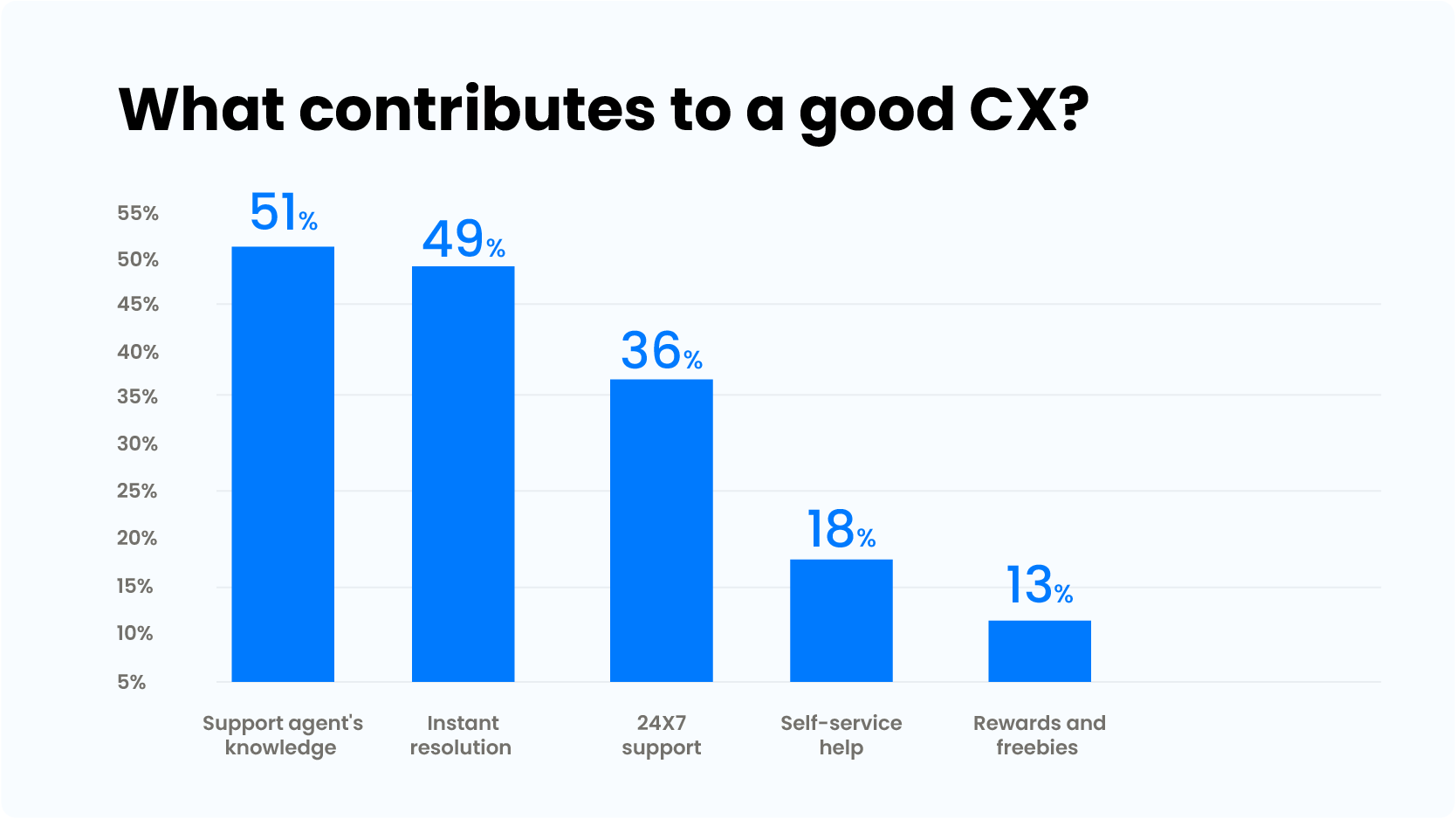
Data privacy and protection:
- Expectation: 79% of consumers state that they are anxious about how businesses use the data they gather. Most customers expect companies to protect their personal information.
- Reality: In 2020, cybercrime cost the international economy over 6 trillion dollars. Companies rarely meet customer data protection expectations.
Customer expectations will only increase over time.
But companies still struggle to meet them.
But why is it important?
It’s simple – customer experience is closely connected to overall sales and business growth.
How Do Customer Experience Impact Sales and Business Growth?
Customer experience is at the heart of rapid business growth. It is the best chance you have at helping your brand grow. As Adobe’s 2021 digital trends report* shows the CX-driven organizations outperform their business objectives.
(*Source: https://business.adobe.com/us/resources/reports/digital-trends-2021.html)
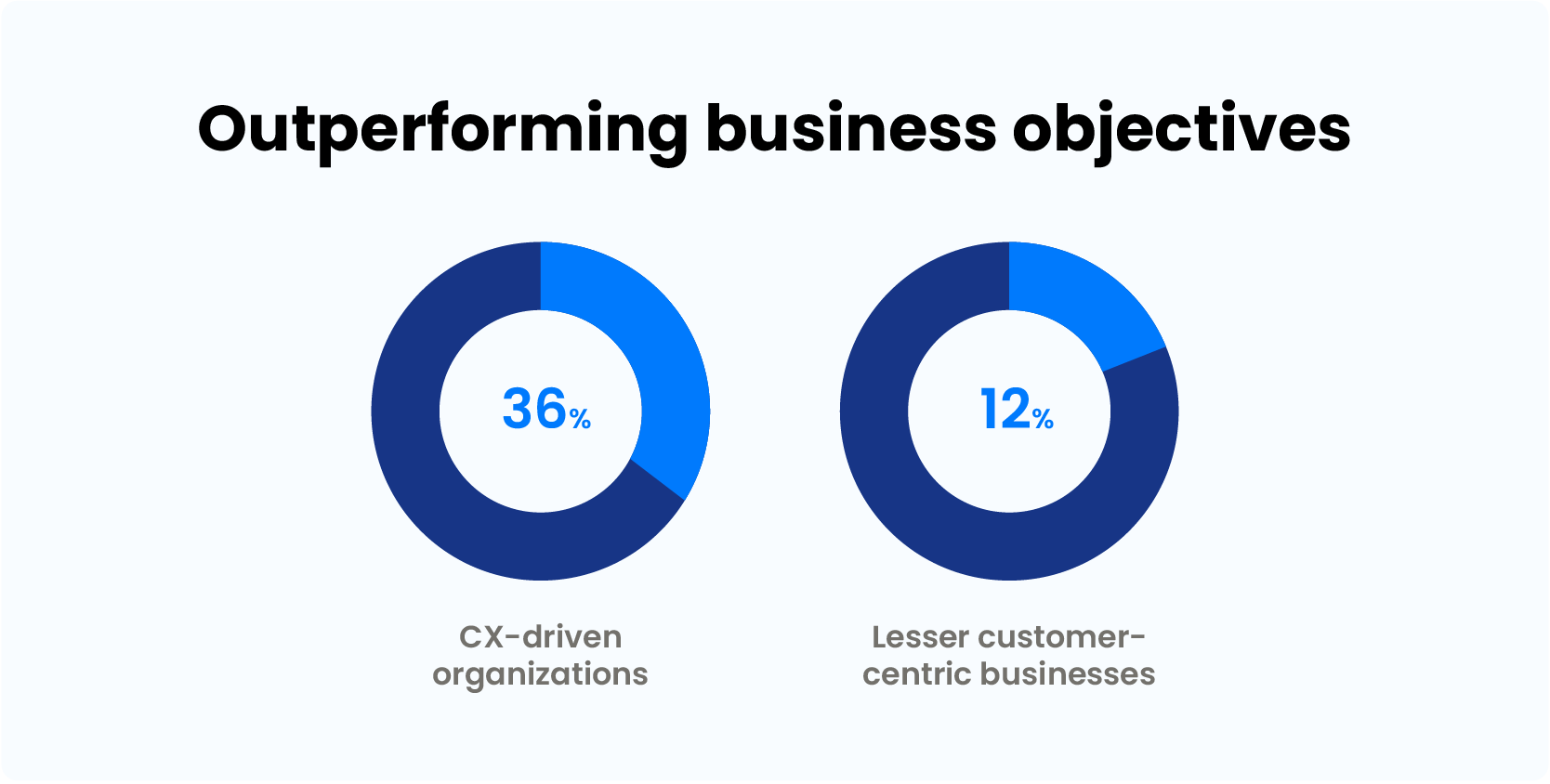
Business growth is often the result of great customer experiences.
An example of how CX impacts business growth is clear with Disney. The “Imagineers” at Disney are master storytellers who engage guests throughout their stay.
We see this in their attention to detail as they design even trash cans that are part of their bigger picture. Disney makes most of its sales by offering customer experiences like none other.
Key takeaway? Sales is another area that profits when customers have positive experiences.
Positive CX is essential to 73% of buyers when related to influencing brand loyalty.
You may wonder why I’ve specifically brought up brand loyalty. It is because 82% of consumers in the United States are product-brand loyal. It also means that they won’t shift to competitors’ products for no reason.
Also, you must have seen that selling is much easier when companies have customers who are loyal to the brand. And by offering stellar CX, you can ensure that your sales forecast stays sunny for days on end.
But what makes up a stellar CX?
Let’s take a look.
How to Deliver the Best Customer Experiences
There are four major components of great customer experiences. They are:
- Personalized products and services
- Seamless omnichannel experiences
- Self-service and live chat options
- Loyalty programs and rewards for customers
1. Personalized products and messages from brands
72% of customers state that they only interact with personalized content.
Marketers also claim that tailored and targeted campaigns increased email revenue by 760%.
There are several ways to personalize your offering. Some of the most effective ones are:
- Creating offers based on their web browsing behavior (behavioral targeting)
- Displaying content and products based on location
- Upselling, cross-selling at checkout. If you’re using a CRM, you can also spot signals through website visits, ad clicks, etc.
- Personalizing communications using their names in emails, chats, WhatsApp messages, and SMS texts
Call this a mantra of customers’ favorite brands – from Grammarly sending weekly progress reports to individuals to Adidas updating the catalog as per the user’s location – we can see personalization in several forms.
The idea is to offer what customers want.
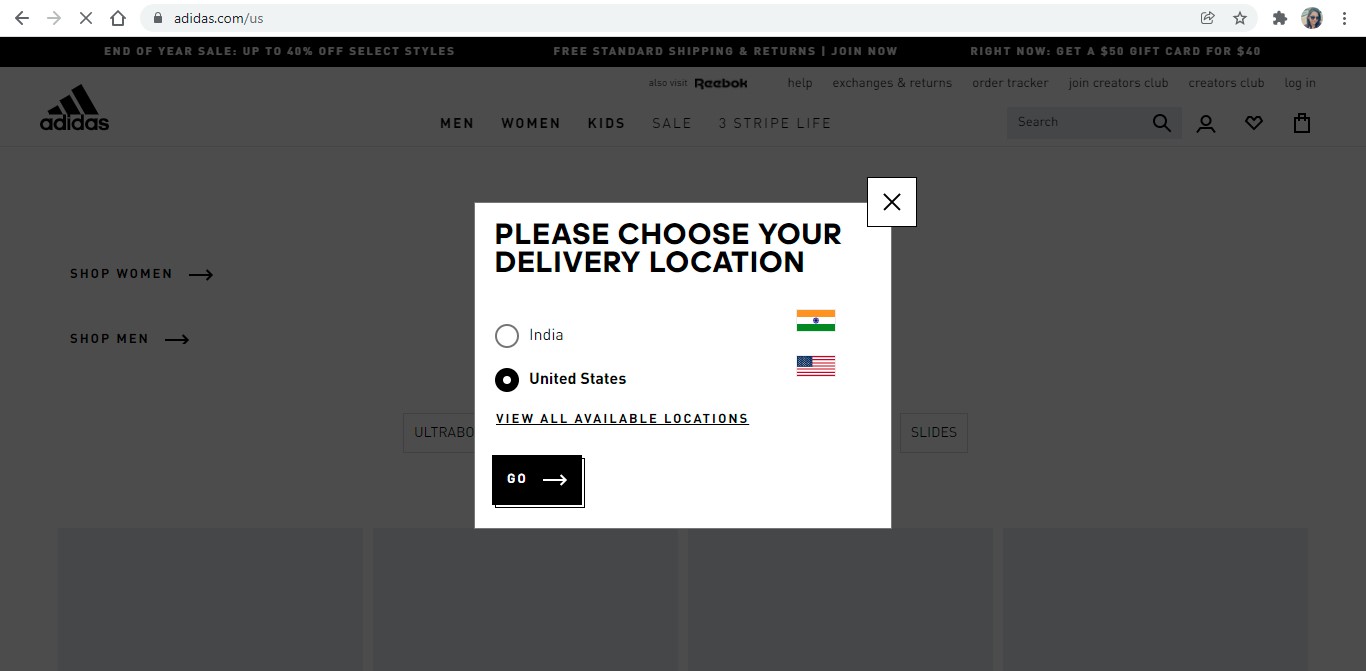
Pro tip: Create customer profiles across different product categories and utilize that information to tune your messaging.
2. Seamless omnichannel experiences
Omnichannel buying rates are 250% higher than single-channel purchase frequency. Customers are constantly shifting from one device to another every other hour. If your content is only readable on the desktop, know that you’re losing sales.
You must make your content uniform and accessible across all platforms.
Starbucks does a great job of using the power of consistent omnichannel experiences. Customers can order and pay for their coffee using the Starbucks app before visiting the cafe to pick it up.
This technique helps the company in two ways –
- One, the customers can avoid the typical in-store wait time.
- And two, the company could gather the customer preference data easily.
A recommendation here is to use a CRM that supports omnichannel communication.
Take, for example, LeadSquared.
It allows you to connect with your customers and prospects through several channels like SMS, WhatsApp, chats, email, phone calls, and more.
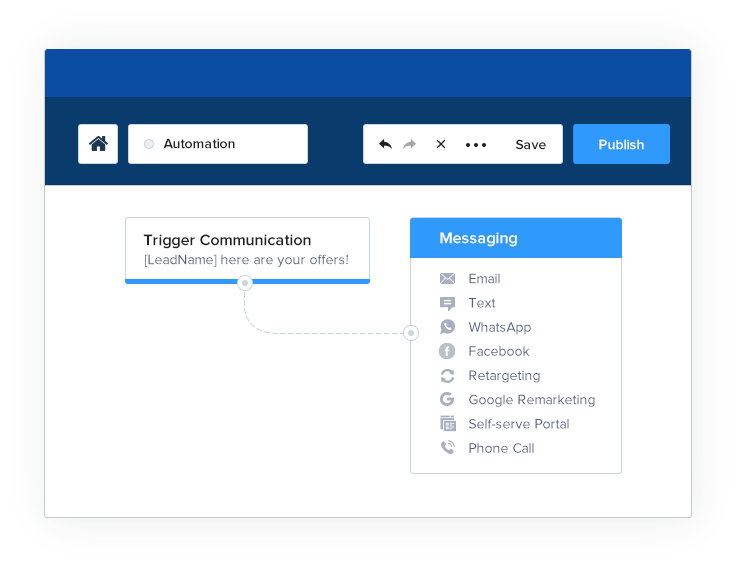
3. Self-service and live chat options
Consumers want to solve their problems or get solutions without assistance most often. This is why self-service, live chat, and chatbot-powered options are popular.
For instance, 87.2% of customers have had favorable or neutral interactions with chatbots. But this is only as long as they can speak with a human if necessary.
Incorporating these elements into your CX can help separate you from the crowd. Customers are bound to flock to your brand if you offer seamless experiences. But, while incorporating these elements, ensure that you don’t remove the human element.
4. Loyalty programs and rewards for existing customers
No matter which company you approach, all of them will agree that it’s easier to sell to an existing customer.
The best method of keeping customers engaged is loyalty programs.
In fact, Gartner also states that CX strategy has a role to play in customer loyalty more than customer acquisition.
“CX drives over two-thirds of customer loyalty, outperforming brand and price combined.”
However, only 29% of CX leaders believe they have achieved intended results in creating innovative experiences for their customers.
The reason?
A gap between what customers really want to stay loyal, and what CX projects focus on.
Gartner proposes four categories of customer experiences that could impact loyalty.
- Interaction experience involving quality, convenience, personalization, uniqueness, and in-experience learning.
- Product experience involving utility, usability, alignment with needs, and life enrichment.
- Brand perception involving brand leadership and its alignment with the customer’s values.
- Value for the price.
Instead of focusing on just app/website experience, considering all the aspects of CX can help win customers for a lifetime.
It’s about tying things together, holistically.
But how do you know if your CX strategy is successful or not?
Here’s 5 of the most significant CX KPIs to track.
Top 5 Customer Experience KPIs
1. Customer Lifetime Value (CLV)
Customer Lifetime Value (CLV) is the estimated revenue that a customer will contribute to a company. We calculate the CLV from the beginning to the end of the customer’s journey in the company.

Customer lifetime value is a great indicator of experiences your customer has with your brand. When CLV is high you can rest easy about your company’s retention as well. If not, figuring out the blockers could help.
2. Customer Acquisition Cost
The cost of acquiring a new customer is what we call- Customer Acquisition Cost (CAC). The formula for CAC is:

Customer acquisition costs show the amount of money you need to invest to bring in new customers.
Creating positive customer experiences can help reduce this cost immensely.
For instance, 72% of customers are likely to talk about a good experience with six or more individuals. It can lead to an increase in overall customer acquisition at little to no cost.
3. Net Promoter Score
The Net Promoter Score (NPS) is a consumer feedback metric that assesses brand loyalty. We calculate the NPS using a scaled survey that ranges from -100 to +100. The formula for NPS is as follows:

Consumers who are loyal to a brand and recommend it to others are what we call “promoters”. In contrast, unhappy customers who are unlikely to return are “detractors”. Anyone who falls somewhere between these two categories is a passive buyer.
4. Customer Retention Rate
The percentage of consumers who stay with a brand over a period of time is the customer retention rate. The formula to find your company’s CRR is as follows:

Customer retention, like CLV, is critical to a company’s growth. The higher the retention rate, the greater is your customer satisfaction.
5. Customer Satisfaction
We assess customer satisfaction (CSAT) using a customer feedback survey. Only clients who rate a 4 or 5 on a scale of 1 to 5 show high levels of satisfaction.

We must measure CSAT consistently to identify a consumer’s pain points. Customer satisfaction is vital for a firm to succeed. As even one unsatisfied customer can result in harmful brand attention.
These metrics help measure customer experiences and areas that need improvement. Once you figure out what needs help, you need the right tools to fix those areas.
To sum up:
If your CX strategy is effective, then acquiring new customers will be a lot cheaper and existing customers will be happy, loyal and do business with you for a very long time.
Tools That Help Improve CX
As Henry Ford says,
If you need a machine and don’t buy it, then you will ultimately find that you have paid for it and don’t have it.
Here are our software recommendations for improving the customer experience.
CRM
CRM stands for customer relationship management. It is one of the most popular categories in the enterprise software segment.
But how does CRM help in improving CX?
Here’s your answer.
- CRM tools help extend the depth and breadth of customer relationships
- It helps minimize transaction barriers
- It helps focus more on customer value and satisfaction
- By segmenting customers based on their interests, geography, and more, CRM helps deliver personalized content.
- Through omnichannel communication, the customer gets a consistent content experience irrespective of the platform.
The best CRM software to improve customer experiences is LeadSquared.
It bridges the gap between sales, marketing, operations, and support by bringing together all the customer interactions (with marketing, sales, and more) in one place.
Be it your marketing team or sales team – all have the same up-to-date knowledge about the customers. This knowledge helps tune the message, identify pain points, and curate content accordingly.
Another thing: LeadSquared supports omnichannel communication. That is, you can converse with your customers through several different channels while still maintaining a record of all communications.
Customer analytics software
There are several aspects to customer analysis.
For example,
- Behavioral analytics. It includes which features they use most, how they interact with your product and marketing messages, etc.
- Customer acquisition channels.
- Mapping customer journey and analyzing all the touchpoints from the first point of contact to conversion.
- Number and types of support tickets
You may find a number of tools to gain insights on individual subjects. Some of the popular tools for these are Google Analytics, Mixpanel, and Kissmetrics.
Self-service portals
A self-service portal helps users find answers and resolve their issues through guided information and resources. It is usually a knowledge base with a collection of FAQs, articles, videos, diagrams, and how-to guides.
Below are some of the capabilities that can be offered through self-service portals:
- Password reset
- Log a service request and track status
- Payments
- User manuals and help documentation
You can also integrate self-service portals with CRM to get a 360-degree view of your customers. For example, LeadSquared allows you to build portals and unify communications with leads and prospects.
Chatbots
Chatbots are very helpful for instant query resolution.
And there’s no other channel that comes close, in terms of expectations, than Chatbots.
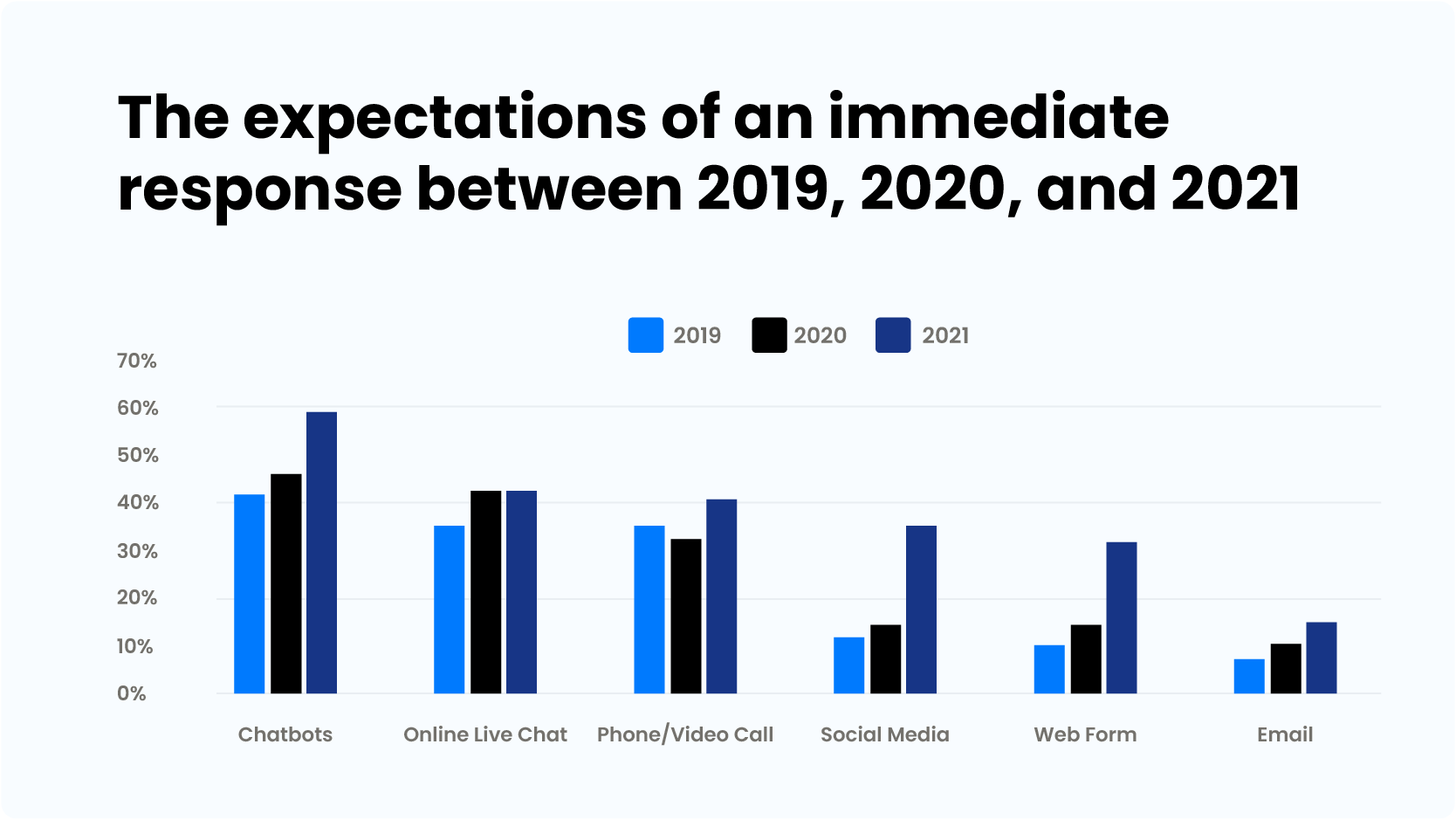
You’ll find two types of chat options – live chat and chatbots.
In live chats, a human agent responds to the customer query. On the other hand, chatbots are software programs that send a canned or automated response to common customer queries.
Depending on your needs, you can select either bots or live chats or a hybrid option – where the bot instantly connects to the human agent if the queries can’t be resolved automatically.
You must have seen how Amazon has automated returns and refunds through bots. In most cases, customers don’t need to get in touch with human agents while also getting their concerns resolved within seconds.
If you’re looking for a chatbot for your website or support portal, you may consider Chatbot, Drift, Acquire.io, Tars, and ManyChat.
Note, the use of chatbots is not limited to the customer support department. Sales and marketing are increasingly using chatbots for lead generation and qualification.
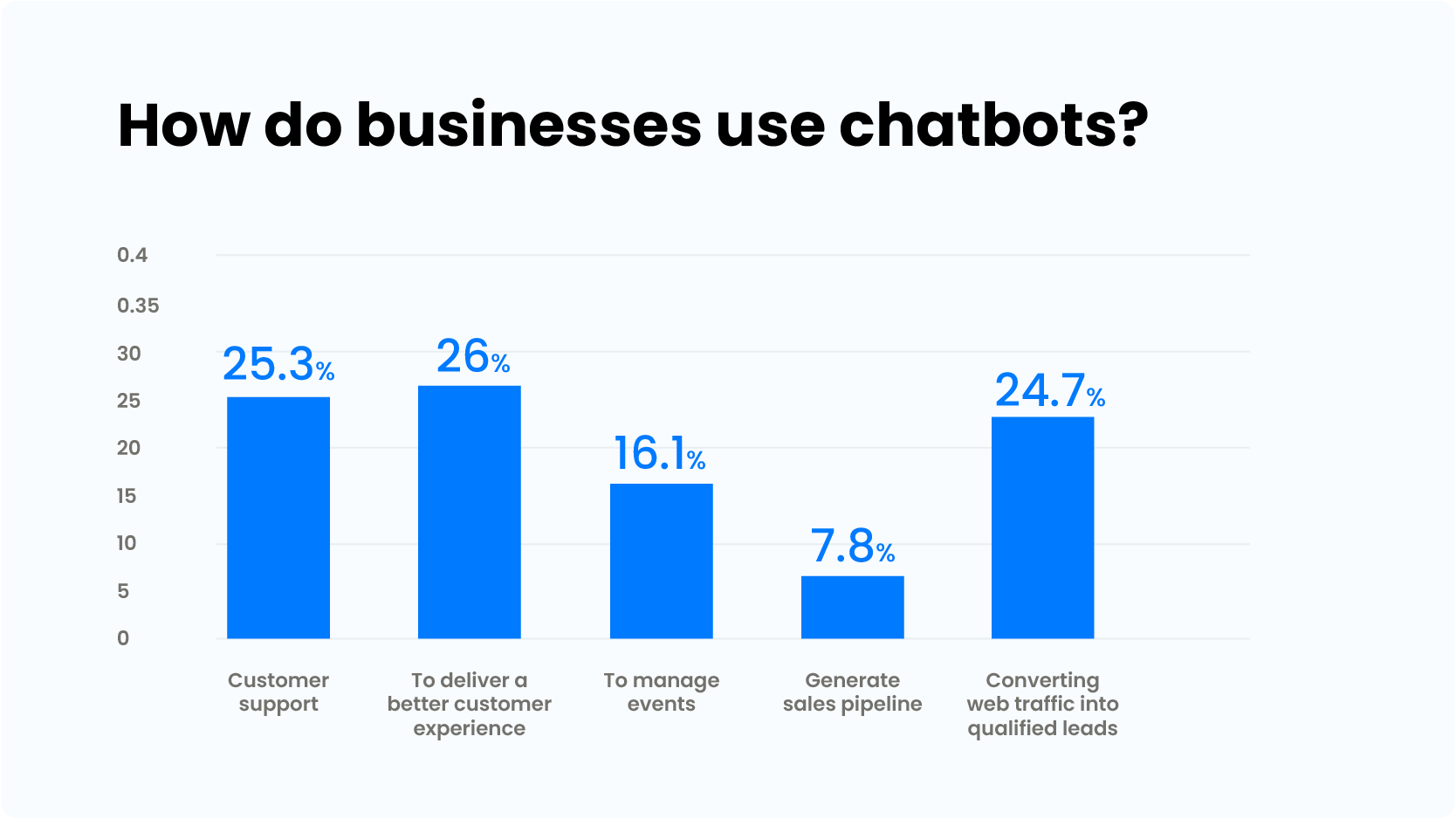
Feedback tools
As mentioned, customer satisfaction is one of the crucial metrics for evaluating CX.
And what’s better than asking the customers themselves.
Feedback and surveys are the most common methods of understanding what customers feel about your brand. Now, there are many ways to take surveys and feedback. But make sure the system you opt for is easy to use and reliable.
Some popular tools to conduct surveys are Survey Monkey, Typeform, and Qualtrics.
Social media listening tools
When it comes to customer experience, social media is a treasure trove of knowledge. You need to keep an eye out for your brand’s reputation online. Otherwise, you’ll end up feeling unclear about your brand’s reputation.
Social media listening also involves monitoring:
- Consumer trends
- Brand perception
- Conversations related to your brand
- Discover potential customers
- Customer engagement
Some of the best social media listening tools are Hootsuite and Sprout Social.
In Conclusion
Growth and success are synonymous with positive customer experiences.
Keep customers happy and they’ll continue to buy from you.
Sounds easy enough, right?
Make sure that your company pushes for a positive CX as much as possible. This means taking accountability for mistakes and staying transparent with your customers. Once you successfully do so, you’ll have a customer base who will be ready to stay.
The opportunity to deliver a superior customer experience is unique. Not many companies are doing so, which means any improvement you make will have an impact on your bottom line.
But you have to act now.
Educate your colleagues on what CX is and how it can benefit your organization. Start small, track the right KPIs and use the right tools, and you’ll be on your way to delivering better customer experiences in no time.
Over 1000+ brands globally use LeadSquared CRM software to nurture their customers. LeadSquared is the way to go if you’re searching for tools that help you create the best customer journeys.





